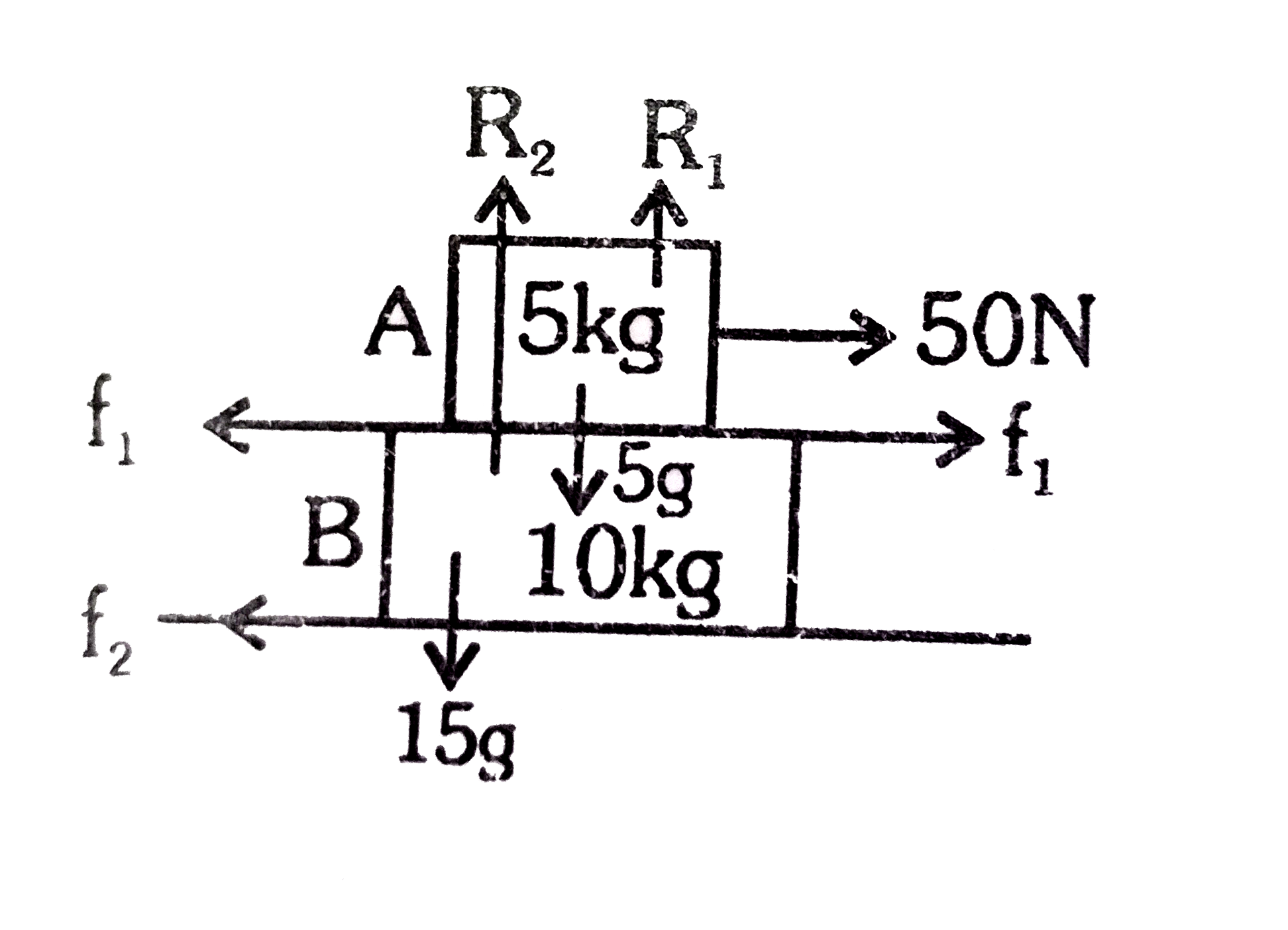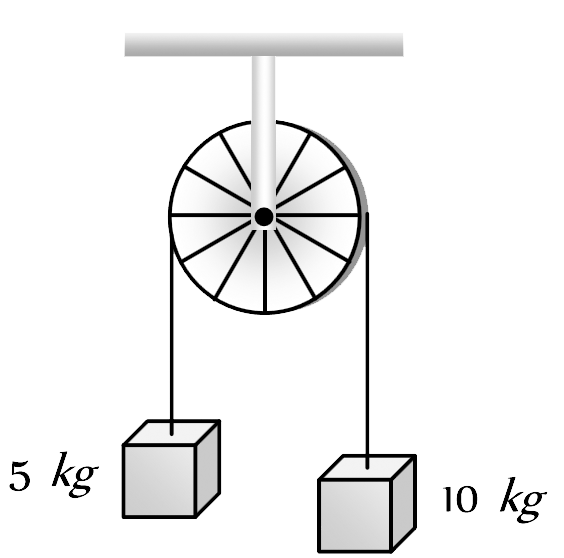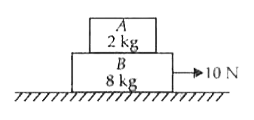Blocks A and B of masses 5 kg and 10kg are placed as shown in figure. If block A is pulled with 50 N. Find out acceleration of the A and B. if coefficient of friction between A and B is 0.5and between B and ground is 0.4.
 Solution in Gujrati
Solution in Gujrati

Limiting friction between A and B, f1=μ1R1=0.5×5g=24.5N
Limiting friction between B and ground f2=μ2R2=0.4×15g=58.8N
For block A50−f1=5×a⇒50−24.5=5×a⇒a=5.1m/s2
For block B accelerating force f1=24.5N is less than limiting friction f2=58.8N so block B will remain at rest.
Topper's Solved these Questions
- NEWTONS LAWS OF MOTIONBOOK - ALLEN CHAPTER - NEWTONS LAWS OF MOTIONEXERCISE - EXERCISE-I
52 Videos
- NEWTONS LAWS OF MOTIONBOOK - ALLEN CHAPTER - NEWTONS LAWS OF MOTIONEXERCISE - EXERCISE-II
112 Videos
- NEWTONS LAWS OF MOTIONBOOK - ALLEN CHAPTER - NEWTONS LAWS OF MOTIONEXERCISE - EXERCISE-III
28 Videos
- NEWTON'S LAWS OF MOTION & FRICTIONBOOK - ALLEN CHAPTER - NEWTON'S LAWS OF MOTION & FRICTIONEXERCISE - EXERCISE (JA)
4 Videos
- RACEBOOK - ALLEN CHAPTER - RACEEXERCISE - Basic Maths (Wave Motion & Dopplers Effect) (Stationary waves & doppler effect, beats)
25 Videos
Similar Questions
USS 150) Two masses of 5 kg and 10 kg are connected to a pulley as shown. What will be the acceleration of the system (g= acceleration due to gravity)

View SolutionA particle is in straight line motion with uniform velocity A force is not required
View SolutionAssertion: The driver in a vechicle moving with a constant speed on a straight road is in a non-inertial frame of referance.
Reason: A reference frame in which Newton's laws of motion are applicable is non-inertial.
View SolutionA piece of wire is bent in the shape of a parabola y=kx2 (y-axis vertical) with a bead of mass m on it. The bead can slide on the wire without friction. It stays at the lowest point of the parabola when the wire is at rest. The wire is now accelerated parallel to the x-axis with a constant acceleration a. The distance of the new equilibrium position of the bead, where the bead can stay at rest with respect to the wire, from the y-axis is:
View SolutionThe frequency of a radar is 780 MHz. After getting reflected from an approaching aeroplane, the apparent frequency is more than the actual frequency by 2.6 kHz. The aeroplane has a speed of
View SolutionAs shown in figure, A is a man of mass 60 kg standing on a block B of mass 40 kg kept on ground. The coefficient of friction between the feet of the man and the block is 0.3 and that between B and the ground is 0.2 . If the person pulls the string with 125 N force ,then
View SolutionA block A of mass 2kg is placed over smooth block B of mass 4kg which is placed over a smooth horizontal floor The coefficient of friction between A and B is 0.4 when a horizontal forces of magnitude 10N is applied on A the acceleration of block of A and B are

View SolutionBlock B is placed on a smooth surface. Block A is placed on rough surface of bolck B with coefficient of friction 0.60 . The mass of A and B are 2 kg and 4 kg respectively. Find the frictional force between A and B ( in N )
View SolutionThe friction coefficient between the blocks is 0.5 . Find the acceleration of each block if F is equal to (a) 5 N and (b) 20 N .
View SolutionTwo blocks are connected by a string and pulled by a force F = 50 N . If the coefficient of friction between the blocks and the ground is 0.2, friction force between the block B and the ground is :
View SolutionA block of mass 5 kg is (i) pushed in case (A) and (ii) pulled in case (B), by a force F = 20 N, making an angle of 30^(@) with the horizontal, as shown in the figures. The coefficient of friction between the block and floor is mu=0.2 . The difference between the accelerations of the block, in case (B) and case (A) will be: (g=10ms^(-2))
View SolutionBlock A of mass 5 kg is resting on a frictionless floor. Another block B of mass 7kg is resting on it as shown in the figure. The coefficient of friction between the blocks is 0.5 while kinetic friction is 0.4. If a force of 100 N is applied to block B, the acceleration of the block A will be ( g =10 ms^(-2)) :
View Solution100 किग्रा द्रव्यमान का ब्लॉक A, 200 किग्रा द्रव्यमान के ब्लाक B पर रखा हुआ है तथा चित्र में दिखाए अनुसार एक दीवार से बंधा हुआ है। ब्लॉक A और B के बीच घर्षण गुणांक 0.2 तथा ब्लॉक B और जमीन के बीच घर्षण गुणांक 0.3 है। ब्लॉक B को गति देने के लिये न्यूनतम लगाया गया बल F होगा (g = 10 मी से−2)
View SolutionBlock A of mass 2 kg is placed over block B of mass 8 kg .The combination is placed over a rough horizonatal surface .Cofficient of friction between B and the floor is 0.5 .Coefficient of friction berween A and B is 0.4 .A horizontal force of 10 N is applied on block B .The force of friction between A and B is
(g=10 ms−2)

View SolutionThe mass of block A is 100 kg and that of block B is 200 kg. The coefficient of friction between A and B is 0.2 and that between B and ground level is 0.3. The minimum force which will make the block B move, will be:
View SolutionIn the figure shown coefficient of friction between block A and ground is 0.4 and that between wedge and block B is zero. Wedge is fixed. Find tension is string and acceleration of block A if F = 28 N.
View Solution
